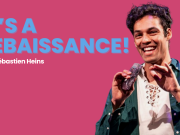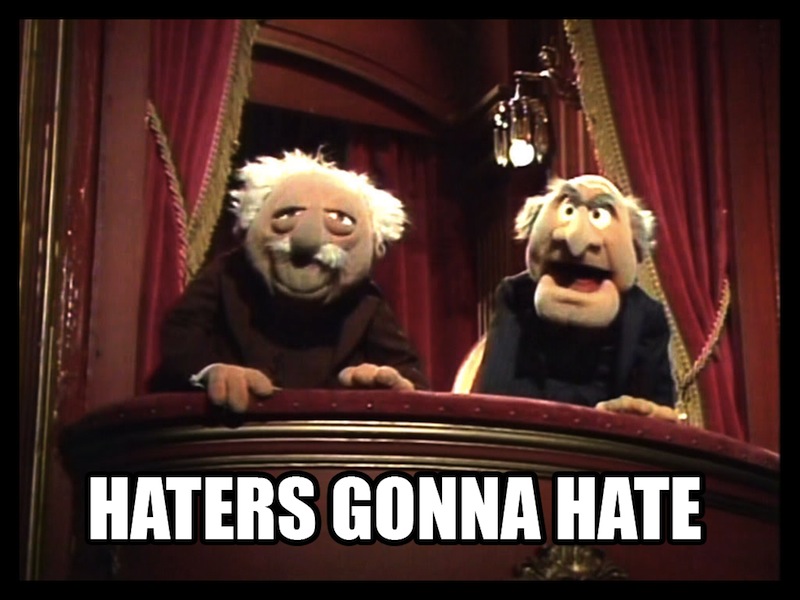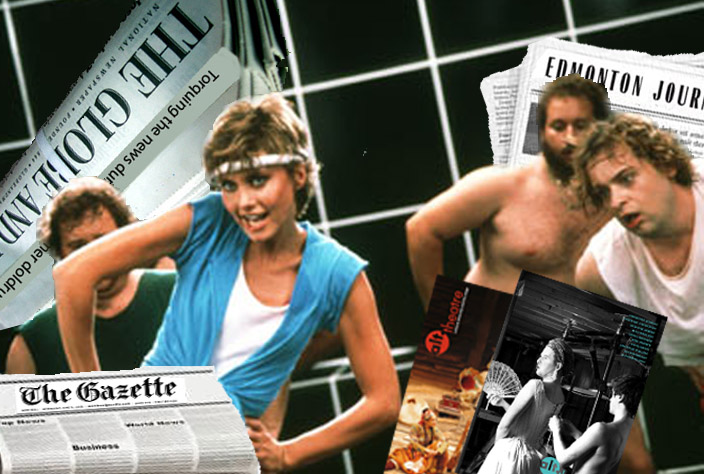Kicking and Screaming: Dragging criticism into the 21st Century
“Theatre criticism is a calling, not a career.”
Mark Brown, a critic for the Sunday Herald in Glasgow, said this to me and 11 others from around the world at The International Association of Theatre Critics’s seminar for critics aged 35 and under last fall. He actually said it several times, lest we finish the four days of play-going and discussion thinking our current passion projects would lead to fame and fortune. It wasn’t an incendiary statement for me then, and it likely doesn’t sound so to you now— like all of the arts, a path in criticism is chosen out of enthusiasm for the form, and rarely anything else.
Like in the performing arts industry, there is a hierarchal structure in theatre criticism. But there’s a twist: only a handful of full-time, “legitimate” jobs exist across the country, and with journalism in the state it’s in, it’s unclear whether those positions will exist when their current fillers depart. Nobody, nobody, is in school today with plans on becoming a professional full-time theatre critic—especially not anyone with student debts to pay off or plans on having a family (Brown also pointed out that in the UK, there are currently no full-time female critics with children).
Arts journalism has an interesting parallel to the theatre industry itself: both are supposedly “dying” (whatever that means) industries, suffering from a shrinking audience with shrinking budgets and shrinking attention spans. With the rise of online publications, every click a review gets is as precious as a ticket sold. In theatre, this has translated into various initiatives to target new (possibly younger) audiences: site-specific or immersive theatre (pioneered by Outside the March and Convergence Theatre), pieces that find inventive uses for the online space (Suburban Beast’s rihannaboi95, and this year’s HATCH series at World Stage), or showcase stories that fall outside of Toronto’s typical realm of the older white male (two heroes so far being Theatre Why Not’s A Brimful of Asha and Ins Choi’s Kim’s Convenience). Clearly, there are a few happy stories emerging from this “dying” field, stemming from the innovation of a new generation of theatrical leaders.
The way we cover theatre has not seen a similar sense of innovation: reviews, interviews, and previews sound and look the same as they have for years. Meanwhile, readers have moved online and, like Canadian theatergoers, are searching for new experiences that suit their lifestyles. More than ever, readers are as selective with the pieces they spend precious time reading as they are with dollars they spend on entertainment. And most importantly, they’re looking to see themselves reflected in the pieces they choose to read.
In the latest SWS podcast with Jacob Zimmer and Adrienne Wong Babies Are Racist, Nightswimming Theatre producer Rupal Shah went so far as to claim that white critics are unqualified to review productions made for non-white audiences, and that she won’t read a review if that is the case. First of all, segregating reviews does nothing to help the conversation happening beyond those directly involved in the theatre industry, online or in print. Second, if you don’t regularly read reviews, you don’t have the right to complain. But, also, she may have a point. Diversifying critics will of course encourage a livelier, more inclusive discussion—like in music criticism, which features a healthy mix of cultures and experiences, no doubt because of the wealth of music blogs that have gained professional reputations, discussion of race and culture in an artistic context is usually front and centre. Unfortunately, for the reasons outlined above, theatre criticism isn’t showing any signs of diversifying anytime soon.
This isn’t to discount the number of theatre blogs that have sprouted in Canada, and Toronto especially. They certainly contribute to the much-need diversification of theatre critics working in this country. What they don’t really do is change up the form: everyone follows more or less the same structure, which is an essay-like exploration of the themes, choices, and performances of a production (at least, the good ones are). The kind, say, a Mirvish subscriber would read. Blogs, or other online publications, are the perfect opportunity to find new readers through unconventional methods.
Of course, this would be another task to take on for these already time-crunched volunteer writers, balancing full-time jobs with an industry full of professional and indie companies begging for their time. It seems that the way we cover and discuss the arts isn’t as worthy as making art, at least to the public purse. With no grants, mentorships, or training opportunities available to emerging critics like there are for young artists, it’s highly unlikely that a volunteer (or, something close enough to that) critic will have the time, money, and energy to find a successful alternative for covering and reviewing productions. That’s especially true if we want to maintain the professional reputations that theatre critics (online and in print) have built, and to make sure arts coverage avoids headlines like The First Half Dragged On, But This One Lighting Cue Will Change Your Life or constructing reviews entirely in GIFs (though, cat photos works pretty well). After all, up until relatively recently, no one has really been complaining.
The good news is that, following the trend of theatre criticism so far, there’s little threat of it devolving into pure lifestyle journalism—like Ted Gioia recently argued about music journalism in The Daily Beast. I believe a reason for the stagnation of theatre criticism is simply because there hasn’t been a need, or want, to do so. It just hasn’t been a conversation with deeply invested participants. I believe it’s an important one to have, so it’s encouraging to see an issue of #CdnCult Times devoted specifically to this issue. Jacob Zimmer said himself in the SWS podcast, “I believe the French New Wave happened because they were talking about themselves.” So far, critics have been involved in the conversation around the art happening in Canada, and not about who’s been leading that conversation, and how they’re doing it.
Let’s get critical
The first time I fancied myself an arts critic was in 1998. I was a ’tween in the GTA and learned that the Toronto Sun held a regular contest in which readers could submit a movie review for consideration. I typed up my thoughts on Armageddon, taking care to balance my skepticism of the plot’s believability with honest praise for the mix of action, science fiction, and romance that enabled the film to truly offer something for everybody. I mailed it in, and to my delight, they ran it. I received two passes to Cineplex Odeon as payment and used them the following year to see The Matrix, my review for which was again champion of the Sun’s weekly prize. That second foray was, incidentally, the last time I ever considered myself an arts critic.
What I am trying to say here – other than that the Sun quite literally publishes work written by twelve-year-olds – is that I do not conceive of the theatre writing I produce and curate to be the work of “critics”. In truth, I never really thought much about theatre criticism as a practice before I was invited to discuss the topic for #CdnCult Times. As Editor-in-Chief of alt.theatre, Canada’s only professional journal dedicated to the intersections between politics, cultural plurality, social activism, and the stage, I have the fortune of constant exposure to thoughtful, reflective and reflexive writing about contemporary performing arts. While this writing is certainly critical, I had yet to conceive of it as criticism per se, and I imagine this is because I’ve come to understand “theatre criticism” to belong to the world of “theatre reviews”, an entirely different beast.
As a theatre maker, when I’m in the middle of a project, reviews are, of course, an important source of promotion – marketing soundbites, reassurance that audiences might steer their attention toward this work. But when I am the theatre-goer myself I rarely seek reviews for guidance, nor do I necessarily give them credence when they fall into my inbox or newsfeed. Why am I often indifferent to or even circumspect about theatre reviews, when off-stage critical discourse is one of the aspects I value most about the industry and the craft? Perhaps it’s because I’m wary of the relationship between reviews and the (in)accessibility of theatre in this land called Canada. Our professional theatre landscape has in many ways evolved to be inaccessible to audiences and artists alike. My question is: does theatre criticism – reviews and otherwise – help to enable or disable this inaccessibility? What is the utility of theatre reviewing, a task inherently about judgment, in a country where theatre institutions still favour the stories, bodies, practices and world views of the those who are privileged (by class, race, gender, ability, etc)?
Our taste palettes are constructed, and well beyond the polite divergences of “you like coffee, I like tea”. The way we experience art is shaped by what we are taught in our childhoods, in our communities of origin, and through our embodied experiences. What songs are memorable? What images are nostalgic? Who is allowed to have a voice? Who is supposed to be powerful? What should or should not be discussed in mixed company? What is beautiful? What is ugly?
In an alt.theatre editorial entitled “When Politics Gets Personal”, Rahul Varma contests theatre reviewers who begin their critiques with a belief that art can and should be ideology-free. He argues that in Montreal’s theatre landscape some critics “[create] boundaries between political and personal when there is none” and in doing so “apply the yardstick of conventional family drama to a genre of political theatre that is hugely complex” (6). Elsewhere, Yvette Nolan expresses frustration at reviewers who assess theatre exclusively through Western artistic conventions and their own assumptions of what “Aboriginal issues” should be: “I am frustrated by the refusal to see… what it is we are doing. I am frustrated by the refusal of the reviewers to try to know, to educate themselves. I have learned the iconography, I have learned the tropes of Western theatre. I have learned to recognize a metaphor when I see one… I know that white represents good and pure, black is bad, and purple royal” (33). If the most-read reviewers are serving to maintain the status quo of theatre, then they are serving its inaccessibility.
I still believe the task of the theatre reviewer can be valuable. An arts critic friend recently summed up for me that when he sees theatre for purposes of review, his task boils down to three questions: a) what did the creators set out to do? b) did they succeed in their task? c) in doing so, did they offer anything new? This explanation of the craft interests me. If theatre communities (creators, audiences, those in between) are to support a practice that is inherently about judgment, then how can or should those reviewing locate themselves (their contexts, biases, experiences) within the critique? The task of the reviewer can offer so much for those looking for windows into new work in their communities. May those who take up the task do so with care, rigor, and reflexivity.
Let us encourage critical discourse about theatre in writing, in person and all sorts of contexts. Let’s include audiences in these discussions. Let’s create more spaces to challenge and inspire each other, to investigate methodology, to celebrate innovation, and to cultivate an artistic ecology that is diverse, fertile, and abundant.
Works Cited
Nolan, Yvette. “Dispatch”. alt.theatre: cultural diversity and the stage 6.1 (2008): 33.
Varma, Rahul. “When Politics Gets Personal”. alt.theatre: cultural diversity and the stage 7.3 (2010): 4-6.
The increasingly permeable divide between artists and critics

When we started the Praxis blog in 2006 it had one golden rule: No reviews.
We felt as artists we wanted to communicate with and about other artists. If the site passed judgment on artistic merit of our colleagues’ work, we would always be outsiders. This seemed antithetical to our aims.
I still think this was a wise decision and allowed the site to grow and become accepted quite quickly. Looking around at what is going on in the theatrosphere these days, the notion seems antiquated. The lines are blurring. Johnnie Walker has reviewed for Torontoist, as well as being a theatre artist on the front of NOW who gets top marks from The Grid, virtually all of the other blogs that have achieved longevity have some ‘review-based’ content, and most importantly, the most rigorous discussion that I can find on theatre these days is the one taking place between artists, critics, and bloggers on social media.
The notion that the artist/critic/blogger divide has become quite permeable became most obvious when World Stage brought controversial Conte d’amour to Harbourfront Centre. Touring the world for the past four years, this is a production that has oozed controversy as a three-hour piece dealing with the real-life story of Josef Fritzl who secretly kept his daughter prisoner for twenty-four years, raising incestuous children with her. Even champions of the show have described it as a difficult, durational work, and it has been both lauded and lamented by critics and audiences alike.
I first became aware of this controversy when the day after opening night, colleagues who had been at the performance related Globe and Mail Theatre Critic Kelly Nestruck had stood up and booed at the end. A 0 star review followed quickly thereafter. This was reported to me by two different artists whom I respect and work with who found the production both successful and important. A number of other reviews came out, most negative. What happened next I found fascinating: Artists, bloggers and mainstream critics began to debate the work further through social media.
There were several posts in my various newsfeeds encouraging me to ignore the critics and see a truly challenging international work. Matters escalated when online review site Charlebois Post elected to post a review of the show even though their critic had left halfway through the performance. Theatre artist Frank Cox O’Connell was the first to respond in the comments:
“ hated it for two hours and then something shifted for me. (That was my experience, it might have not been yours, we won’t know.) You can certainly walk out, but then don’t write about the work… You didn’t see the work.”
At this point, having not seen the show, but being supremely annoyed by the lack of professionalism in my beloved theatrosphere, I felt compelled to engage @CharPoCanada on the topic of reviewing what you have not seen:
@CharPoCanada a review of durational work where critic leaves early is like reporting on first 3 quarters of a @Raptors game. #whatsthepoint
— Michael Wheeler (@michaelcwheeler) April 4, 2014
@michaelcwheeler Oh, we will never agree on this one.
— CharPo Canada (@CharPoCanada) April 4, 2014
@CharPoCanada if point of a work is how it impacts you over a period of time & critic leaves, no reason to consider thoughts on work.
— Michael Wheeler (@michaelcwheeler) April 4, 2014
@michaelcwheeler Using your Raptors analogy: if the score is 120-0, I think it’s safe for commentators to move to another game.
— CharPo Canada (@CharPoCanada) April 4, 2014
@CharPoCanada would you actually read an article that said the raptors were down big, but i have no idea what happened at the end?
— Michael Wheeler (@michaelcwheeler) April 4, 2014
@CharPoCanada this a difference between audience and critic. audience gets to leave when they like, critics have to stay to do their jobs.
— Michael Wheeler (@michaelcwheeler) April 4, 2014
After this first wave of pushback from artists like about the behaviour that should be expected from those that self-identify as critics, the critics themselves began to weigh in:
Not wild about @CharPoCanada reviewer’s decision to leave Conte d’amour, but review anyway: http://t.co/SdkDN6pfDh — J. Kelly Nestruck (@nestruck) April 4, 2014
.@nestruck @CharPoCanada Leaving before a show ends turns a review into an op-ed. I fully agree a reviewer should know how a show ends. — Steve Fisher (@GracingTheStage) April 4, 2014
@GracingTheStage @nestruck Er…what makes a review superior to an op-ed? Or 1 reviewer’s opinion more valuable than a person who left? — CharPo Canada (@CharPoCanada) April 4, 2014
@CharPoCanada @GracingTheStage Opinion is the least important part of a review. — J. Kelly Nestruck (@nestruck) April 5, 2014
@nestruck @GracingTheStage Hmm… display of erudition? — CharPo Canada (@CharPoCanada) April 5, 2014
@CharPoCanada @nestruck @gracingthestage For 1 thing – audience pays, has right to leave. Reviewer invited, has obligation to see it through — Carly Maga (@RadioMaga) April 5, 2014
@RadioMaga @nestruck @GracingTheStage Where the hell does this list of obligations come from? — CharPo Canada (@CharPoCanada) April 5, 2014
@CharPoCanada @RadioMaga @GracingTheStage Honestly, I think the one and only obligation for a review is to watch the thing you are reviewing
— J. Kelly Nestruck (@nestruck) April 5, 2014
@nestruck @RadioMaga @GracingTheStage Again obligation. How about the obligation of theatre creators to keep me in my seat?
— CharPo Canada (@CharPoCanada) April 5, 2014
@CharPoCanada @nestruck @gracingthestage @michaelcwheeler If you MUST leave, you’re doing so as an audience member. And don’t review it.
— Carly Maga (@RadioMaga) April 5, 2014
@RadioMaga @nestruck @GracingTheStage @michaelcwheeler Balderdash.
— CharPo Canada (@CharPoCanada) April 5, 2014
After this, things got nasty and personal in a way that only the internet can empower. I haven’t included it, because I don’t find those conversations useful. What is also not included are comments and RTs by CIUT’s @Slotkinletter and NOW Magazine’s @GlennSumi, who also condemned the practice of publishing a review of a show that the critic only saw half of. One can assume The Toronto Star didn’t get in on the action only because none of their critics have elected to join the 21st Century and the rest of their colleagues for these important conversations on Twitter.
Regardless, critics from traditional media seemed to have achieved quorum in this exchange – and at this moment the theatrosphere self-corrected. This gives me hope for the future of criticism online. There is no escaping the exchange of ideas in this community, and while I am reticent to use meritocracy in any late-capitalist context, it does seem like the best analysis can rise to the top, the worst can be shunned; and that this can all exist in a rigorous discussion with diverse perspectives that includes theatre-makers, theatre-writers, and those of us who do some of both.
I still don’t think PraxisTheatre.com will begin running reviews any time soon, but that may not be the point of how these discussions take place anymore. Some of the most compelling conversations about theatre right now are happening in a micro-blogging context, like Facebook and Twitter, and these are forums where everyone can participate.
#CdnCult Times; Volume 3, Edition 1
Welcome back for our 3rd Volume of #CdnCult Times, which will feature a new edition every second Tuesday from now until the end of the summer.
This Edition explores the changing nature of theatre criticism, which is getting some mainstream attention these days as Ben Brantley and his review in The New York Times is attacked by James Franco on social media, while The Guardian’s Lyn Gardner questions if critics are even reviewing the right plays.
The self-publishing revolution is having a profound impact on the small number of critics that once were the sole arbiters of artistic merit, and pushback is coming from many different directions.
Michael Wheeler
Editor-in-Chief: #CdnCult Times
Babies are RACIST!
Podcast: Play in new window | Download
Subscribe: Apple Podcasts | RSS
SWS Podcast 08
In this podcast, Jacob and Adrienne are joined by Rupal Shah to discuss work that comes from cultural contexts other than the dominant mainstream. iTunes | RSS
NOTE: the really boring topic that we try to avoid talking about off the top makes an appearance around 3:30. We appreciate your patience as we work on our technical difficulties. In the meantime, if you or someone you know has experience fix those kind of sounds (full description) let us know. Thank you.
CONTACT US
Jacob’s email
Adrienne’s email
Twitter #SWSpodcast
LINKS TO THINGS WE TALKED ABOUT:
- Our guest, Rupal Shah
- Bad Baby on This American Life
- Definition of ‘racism’
- Definition of ‘xenophobia’
- The Wanderers
- Context from Cahoots
- Martin Morrow review
- Marjorie Chan blog post
- Palace and Folk
- Riverdance
- Shakespeare
- Taylor Mac
- Kim’s Convenience
- Conte D’Amour
- Avignon Festival
- Pig
- Venus in Fur
- French New Wave
- The Shipment by Young Jean Lee’s Theatre Company
- Watch it on On The Boards TV HERE
- The Cold Reading Series
- Recent Experiences by Jacob Wren and Nadia Ross
- Crispin Glover’s What Is It
- Jay Smooth – How To Tell Someone They Sound Racist
Words of Wisdom
Podcast: Play in new window | Download
Subscribe: Apple Podcasts | RSS
SWS Podcast 07
Jacob and Adrienne talk about advice. iTunes | RSS
How to teach toddlers about healthy sexuality. What would we tell young artists at the beginning of their careers. The differences between radio and podcasting. The difference between ‘form’ and ‘format’ and ‘structure’. What is the social function of sadnessWe apologize for the quality of Jacob’s mic. He forgot his good mic at home. It won’t happen again.
CONTACT US
Jacob’s email
Adrienne’s email
Twitter #SWSpodcast
LINKS TO THINGS WE TALKED ABOUT:
- Take Back the Night
- Heteronormative
- Jean Morpugo
- Kenneth Tynan
- Pina Bausch
- Wooster Group
- Tadashi Suzuki
- Jest in Time
- Halifax Music Scene in the 90’s
- Heiner Muller’s [Hamletmachine](http://en.wikipedia.org/wiki/Hamletmachine
- Sally Clark’s Moo
- Marc Diamond’s Survival Guide:
- Bring a newspaper to rehearsal
- Bring twice as many cigarettes as you think you’ll need
- Never steal from the theatre
- Always buy your own drinks
- Always leave the party when you’re still having fun
- Say hello to everyone when you walk in the room
- Management Tools Podcast
- Ira Glass Reading Watching: Original / Meme1 / Meme2
- The Current
- 10,000 hours of practice rule and why it might bewrong
- The Trouble With Bright Girls
- Articles about the search for gender neutral baby clothes HERE and HERE
- The Choreographer’s Handbook by Jonathan Burrows
- PodPlays
- Aristotelian Structure
- David McIntosh
- Upper Toronto
- Sam Mendes’ 25 Rules for Directors
- Viktor Shklovsky, Bertolt Brecht and Verfremdungseffekt, often mistranslated as the ‘Alienation Effect’
- Jean Luc Godard
- Maiko Bae Yamamoto’s thought residency
We didn’t get to this, but here’s a good read. Our friend Dustin Harvey gives himself advice.
Hell Yes
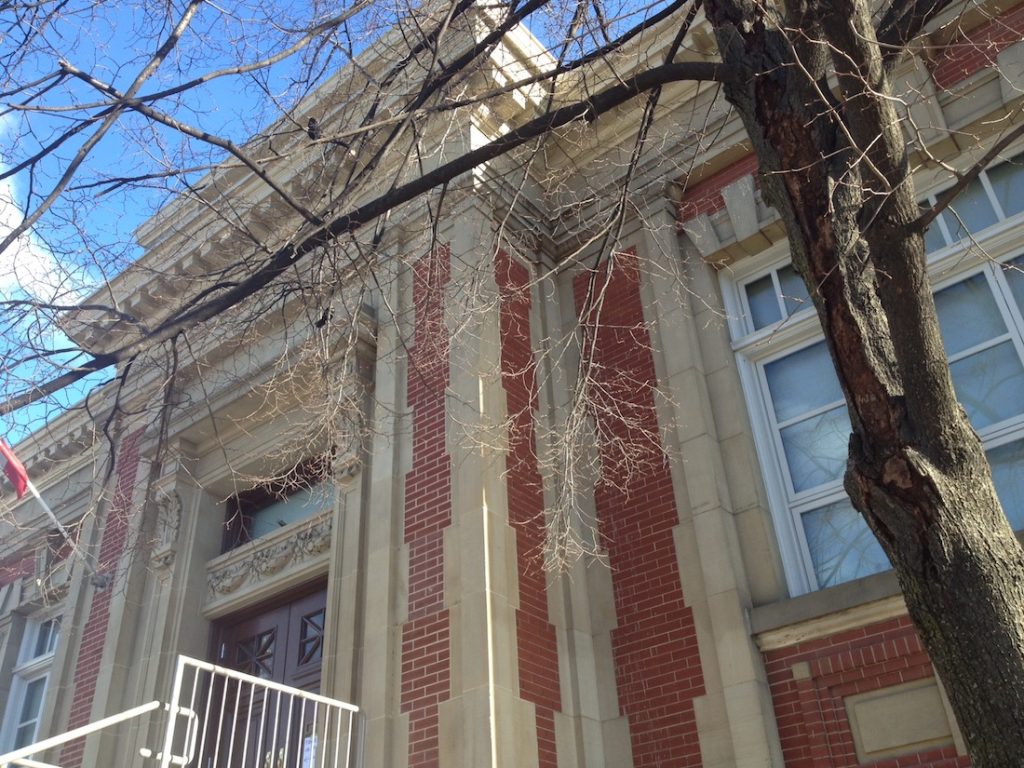
I was in the unheated-until-mid-January, sometimes infested, crowded, old Theatre Centre office working on The Freefall Festival when news arrived that key public funding had been secured for a new home in The Carnegie Library down the street.
It was the moment things became incredibly real. Years of smoke and mirrors were going to turn into steel and concrete. The Theatre Centre, which in its various homes seemed defined by impermanence, was about to become a permanent, integral institution in Toronto‘s cultural landscape.
It’s impossible to separate that the development of Praxis Theatre with this place – or more accurately: this idea, which has been housed in many places. It was home to our first show, our first professionally-produced show, and was where we premiered our most produced show. Freefall 2012 was the first time an artistic director asked me to curate performance, and my article for The Source was the first time someone paid me to write about theatre. It’s difficult for me to imagine what my life as a theatre artist in Toronto would have been like without it.
This is less about access to resources, than perspective and understanding about why I was making the work I was making. When Praxis began, we mostly adapted works of literature for the stage. It seemed a worthy goal, and was how I learned to direct plays. Slowly though, it didn’t seem compelling enough of a reason to live the precarious life of a theatre artist in Toronto. I think Theatre Centre saved me from putting my energies into something other than theatre, by giving me the tools to understand how to keep creating work that was meaningful to myself.
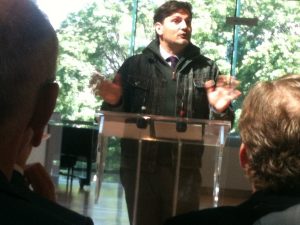
I’m pretty sure no one associates us primarily with literary adaptations anymore. Slowly, under the indirect, never prescriptive, non-linear influence of AD Franco Boni (as well as GMs Cathy Gordon and Roxanne Duncan), Praxis has turned into a company that has a vocal political perspective and willingness to experiment with new forms. This confidence that it is not just okay, but necessary, for artists to speak up for social justice and risk failure in their practice, is what we have gained over the last decade of our various associations with The Theatre Centre.
This is why although it is mind-blowing that Theatre Centre finally has a permanent home, it will remain at its essential core an idea. It is up to the artistic leadership of a company to define that idea precisely at any given time, but I will venture that part of this idea is that politically challenging and artistically compelling works are not mutually exclusive.
This is probably not a newsflash to fans of Brecht, Soyinka, Churchill – heck most of our best dramatists. But to consider how Franco Boni has embodied this notion as an Artistic Director now that this building is a reality is a bit mind-bending. Consider two core elements of the given circumstances of being an Artistic Director in Toronto for the past decade:
1
It has been a terrible time for public and private investment in the arts. Recession and a slew of regressive governments have meant major cuts and basically no new money for local artists. Think for a moment about Harper and ‘Ordinary Canadians’, Don Cherry after Ford was elected, SummerWorks, Rhubarb, Canadian Conference for the Arts. It’s been a dangerous, complicated time to be running an arts institution. People are watching and there are consequences for those that fall out of line.
2
Is there a performance venue more associated with dissent and social justice than Theatre Centre? Not only has it produced work by ATSA, Cape Farewell, Volcano, Bluemouth, and Liza Balkan’s shocking piece on police brutality Out The Window, to name a few; it has also been home to numerous Wrecking Balls, each of the Civil Debates, and amongst other organizing meetings was where Department of Culture began with a packed event led by Naomi Klein.
That 1 + 2 = Multimillion dollar state-of-the-art heritage building and permanent home – it almost doesn’t compute. How is this even possible? Am I dreaming as I write this? It contradicts everything I understand about this era. It is why this article has been in my head for two years, because I have been fascinated with what this means: Success is possible without compromising values.
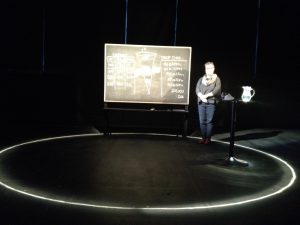
The conclusion I reach from this is ‘Community Organizer’ is also a part of the job description of an Artistic Director. The building to house the idea that is The Theatre Centre was powered in large part by a community that was determined the transformation on Queen West-West led to positive change for everyone who lived there. The community activist group Active 18 was the main focus of these efforts, and this has led to support from local politicians, which was leveraged into more support and so on. This happened because the theatre had an Artistic Director who had an inspiring vision about how the theatre could benefit the community and empower advocates for it.
Tomorrow, The Theatre Centre will open with the World Premiere of Sea Sick by Alanna Mitchell. The play came out of the keynote speech Mitchell made about the crisis caused by the desalination of our oceans when Franco and I co-curated FreeFall in 2012 after he met her through the Cape Farewell initiative to bring together climate change experts and artists. It speaks to the crazy logic of that place that the one non-piece of ‘performance’ we brought to that festival would go on to have the biggest theatrical production.
But it is significant for an even bigger reason: Sea Sick will be the first piece of theatre directed by Franco (with longtime mentee Ravi Jain) as Artistic Director of The Theatre Centre. After a decade of figuring out how to create space for other artists, a play Franco directed will be the first thing to happen on this new stage. It wasn’t planned that way, but construction deadlines have made it that way. To write he has earned it seems neither a bit trite, so I will just write what I think many of my colleagues think when they consider what has been accomplished here:
Hell Yes.
Progress
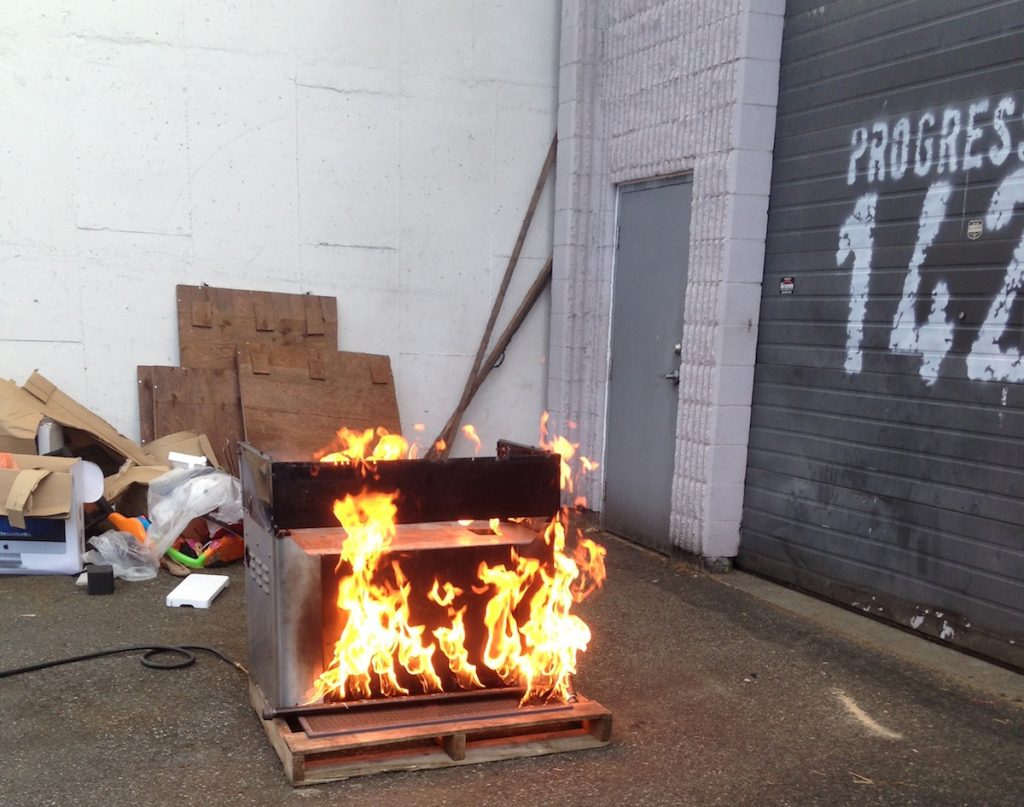
Like many cities in Canada, Vancouver’s over-inflated real estate market has left the cultural sector with fewer and fewer options for administrative, rehearsal and studio spaces. Many of the spaces that are available are unsanitary, poorly heated, insufficiently lit, or have sound bleed issues that make it next to impossible to get anything accomplished. As a freelancer I find myself working in all sorts of spaces, but my favourite place to rehearse is Progress Lab 1422.
Progress Lab 1422 is home to four Vancouver companies – Electric Company, Boca Del Lupo, Neworld Theatre & Rumble Theatre. It used to be a garment factory, but five years ago these four companies pooled their resources and now it has a new life as a rehearsal, administration and development hub. The building was clearly renovated for the purpose of making theatre and building community: the four offices share a kitchen and meeting room with the rehearsal studio.
PL1422 (as it is affectionately known) is an integral part of the Vancouver theatre ecosystem, both as a rehearsal studio and as a community hub.
As a rehearsal venue, it is a step above everything else in town: 1500 square feet of fully sprung floors, a fitting room, 20’ ceilings with box truss in half the space, and technical gear including a sound system, lights, rigging points and a mounted projector. It’s the only rehearsal studio I’ve ever seen someone fly in and I look forward to each project that I know I’m going to be rehearsing there because I know that not only will I be rehearsing in a well equipped and secure space but also because every single day I will run into other artists and creators.
As a community hub, it is unparalleled. PL1422 is not my space in the sense that I do not work for one of the four companies that share the building. However, I feel a sense of ownership towards it despite my rather loose affiliation and I know that others do as well. My first visit to the space was for a wake and my most recent visit was for a surprise birthday party. It is a place where the community gathers for special events – both to celebrate and to grieve together.
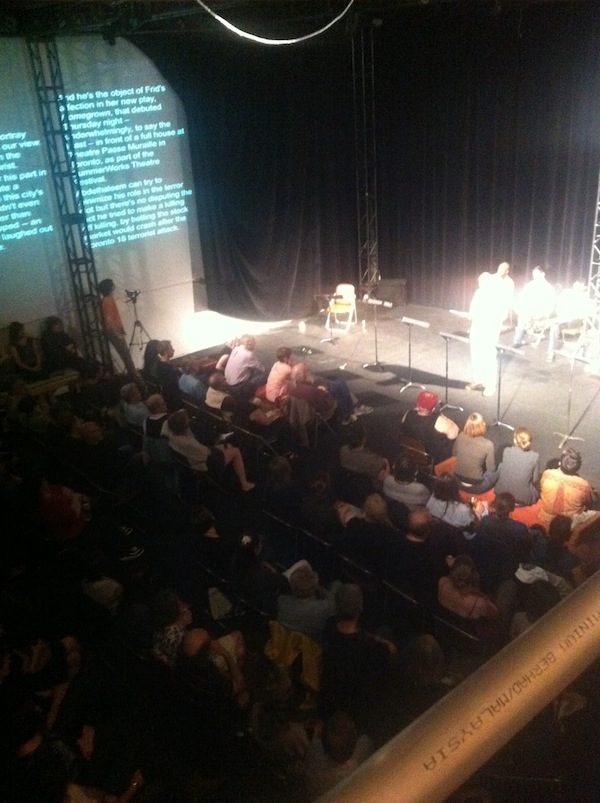
When SummerWorks in Toronto was facing funding issues that were suspected to be as a result of Catherine Frid’s Homegrown, PL1422 hosted a staged reading. During the last civic election PL1422 hosted the Wrecking Ball and played host to many of the city counselors as well as artists for the evening. New Year’s Eve PL1422 welcomed a plethora of partygoers to ring in the year together and fundraise for some young companies. Even company AGM’s have become a communal event with a performance element. The sense of community in that space is palpable and it has pushed the companies involved and those outside to further their artistic rigor.
The best example of this is the very popular and nearly completed Obstructions series where eleven companies who know each other’s strengths & weaknesses as well as each other’s tendencies & crutches challenge each other to work outside of their comfort zone. These one-night-only presentations are always packed, but more excitingly they always end with a discussion about the pieces and whether or not they successfully embraced the challenges they were presented with. I had the opportunity to stage manage one of these pieces and as we created it, we spoke about the obstructions we had been given, what the root of them was, and then the decision was made to disregard one of the obstructions and make the choice to willingly fail that challenge.
What makes these conversations unique is that every person in the room is encouraged to be a part of it: the creators, the companies who challenged them, and the audience all enter into a conversation together with the knowledge that increased artistic rigor is the goal. The air is electric on these nights as ideas and inspirations bounce through the room and artists from both emerging and established companies mingle and new collaborations are sparked.
Collaboration is one of the strengths of the Vancouver theatre ecosystem and spaces like Progress Lab make it easy to see why. The Obstructions series will be completed at the end of April, but I have no doubt that the companies who reside at Progress Lab 1422 as well as the other companies and artists who consider Progress Lab their artistic home will continue to challenge each other, collaborate and celebrate together.
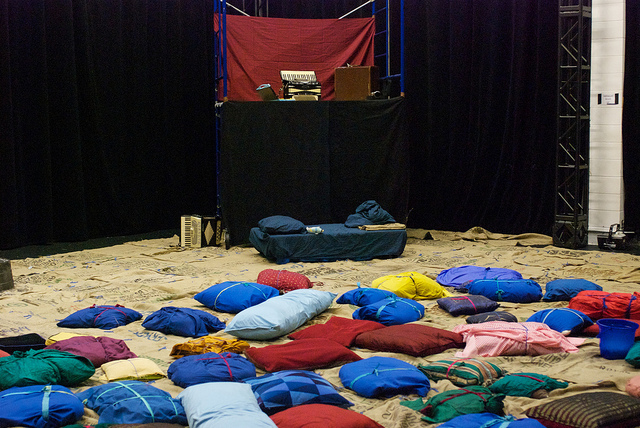
What makes a creative space important?
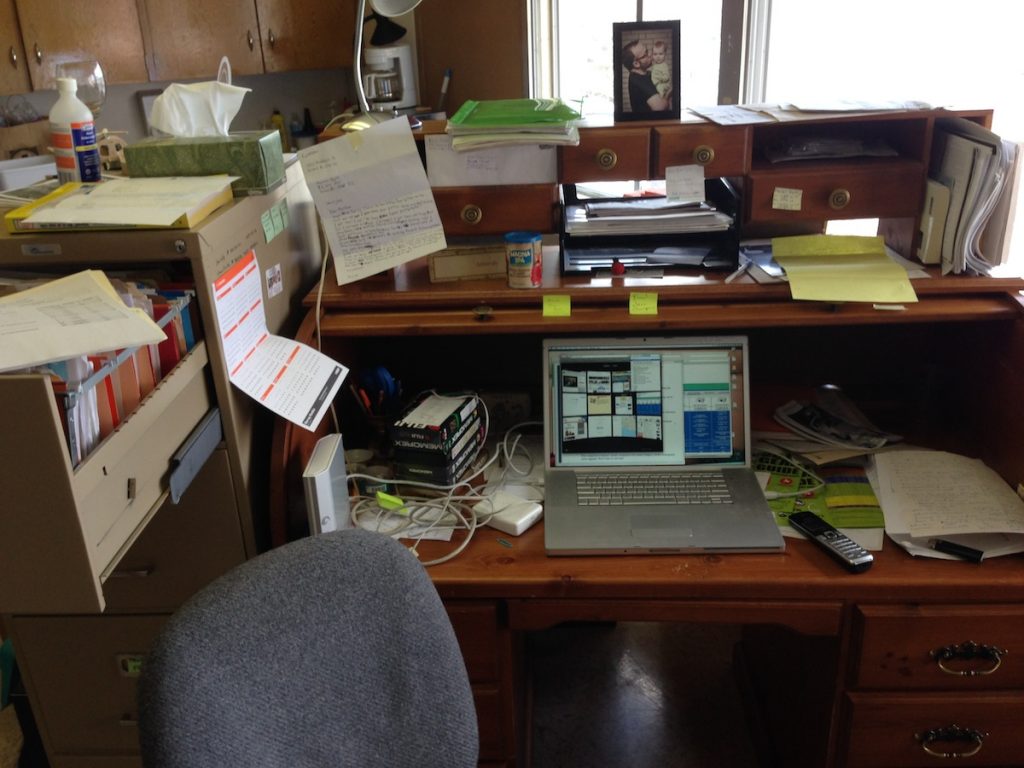
Matthew: How are you?
Laakkuluk: It’s been a tough week, but we’re managing. A teacher that has worked at our daycare since the day it opened died the other day.
Matthew: I am so sorry.
Amy: So sorry Laakkuluk. Was it sudden?
Laakkuluk: Thanks guys. We’re holding up for the kids’ sakes. She likely took her own life.
Amy: We had the suicide of a young man here in St. John’s too.
Laakkuluk: Oh no.
Amy: Andy Jones’ son. He was very sick. The entire community was in shock and grieving.
Matthew: How tragic.
Amy: Andy and Mary-Lynn are very public about it. We all need to speak about mental illness.
Laakkuluk: Yes we do, or it will never get better.
Matthew: This may seem like a poor segue, I was thinking about the creative space of the mind. We know a lot more about the mind now, but there is still mystery. Mental illness is part of that mystery.
Laakkuluk: You are absolutely right: the mind as a creative space that needs to be nurtured and respected.
Amy: Whatever that space has to offer the rest of the room, it has to be respected.
Matthew: And how do we engage with our minds?
Laakkuluk: It’s the ultimate creative space…and maybe really the only one…
Amy: We have no creativity if we deny that space – our own mind, our own ideas. So, like any space, we must look at what we have in that space and use it in the creative process. We must entertain what is in the space and incorporate our assets into the piece. And our asses too, I spose! 🙂
Laakkuluk: The art is in stitching all these spaces together into a coherent and potent piece for everyone.
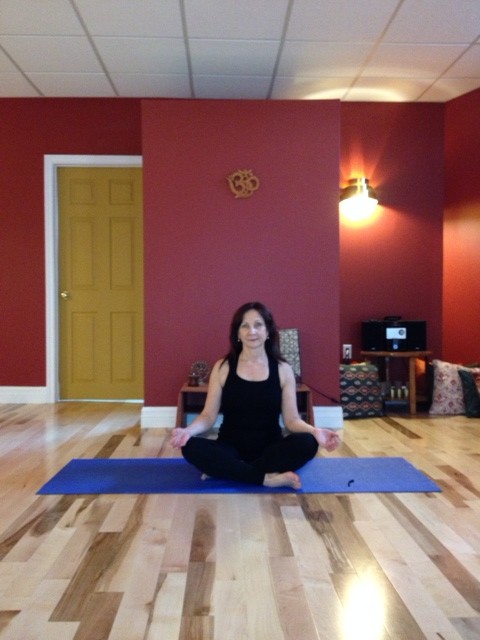
Amy: It’s called a collective. From everyone, for everyone, everyone in the piece and the audience. So, if we start with our mind being the ultimate space, we use our mind to look at the physical space and use that in our creation. We use the physical space depending on what we are creating. We can very seldom, almost never create in the space that we perform. We create, and rehearse and then get 1.5 weeks in the space we are going to perform it, if we are lucky. We usually perform at the LSPU Hall, but we seldom get to just create there. It is expensive. If you are just creating, the box office makes no money.
Laakkuluk: It’s the same at the Greenland national playhouse Amy. It doesn’t have rehearsal or creation space and so when performers are in there, time is money.
Matthew: Laakkuluk we know from past columns you are working towards a regional space there. Right now you have no practical physical space?
Laakkuluk: That’s right. Just after the last chat, we had Nunavut’s first spoken word gathering. We cleared out the nursing students classroom for the workshops. Then we packed up again and cleared out the mezzanine at the high school for the performance.
Amy: How was it?
Laakkuluk: It was sublime.
Matthew: What made it sublime?
Laakkuluk: We had about 20 writers with us, of all different ages, genders, voices. We had 83-year-old elders collaborating with 14-year-old rappers in Inuktitut.
Amy: What was the performance aspect? Was it a reading?
Laakkuluk: It was a combination of readings, music and live performance. The styles of spoken word were quite different from elders’ oral history and storytelling to poetry reading to rap.
Matthew: Sounds like the performers made the creative space important.
Laakkuluk: Yes, here it is all about the performers’ perspectives and experience and never about the space. When we have a performance space, however, the performer’s own mind space will be exponentially expanded.
Amy: Was there any technical aspect? Sound? Lights?
Laakkuluk: We have really great sound engineers that live here; they can make good sound in substandard space. And we have good lighting guys too. The high school has some basic lights and sound that we plug into.
Amy: How many people attended?
Laakkuluk: There were about 150 people there for the performance, which was great for our small city on Oscar’s night Sunday.
Amy: Magical. What did you do?
Laakkuluk: I helped coordinate the whole thing, collaborated with the music makers and read my piece about how “the seal becomes the boy”
Matthew: Congrats on a great event.
Laakkuluk: Thank you! We’re proud of it! I’ll tell you about the finale – I think you’ll like it. After our last song, we broke into a “throat-boxing” session – a mixture of throat singing and beat boxing and in the middle of it all, an elder got up and started calling out his dogsledding commands. All the kids went mad because it was rhythmic and it sounded like the elder was rapping…He was rapping!
Amy: That is amazing. How liberating.
Matthew: Joy! So, Amy, is LSPU Hall the major space in Newfoundland?
Amy: It is a 200-seat theatre. Intimate. It is where most new works are done.
Matthew: Can you articulate how you engage with it? Or how you should engage with it?
Amy: We collaborated on a project called Broken Accidents with Neighbourhood Dance Works. It was just when the hall was closing down for renos. We wanted to workshop in the space so we could use the tech, the stairs in the hall, audience, the back space: discovery in the space. Because of the hall closing down, the board allowed it, so we truly got to experiment, albeit for two weeks, but quite a gift. On the other hand, my friend and I created a play last year and rehearsed it in my office, in a heat wave, and directed it ourselves. Then we went to the Hall Second Space and did our dress rehearsal for staff and friends before hitting the road on tour. It’s all relative. Depends on what you are trying to achieve.
Laakkuluk: You’re pointing out there is a difference between performance space and creation space and you can’t do the performance without some kind of creation space first.
Amy: Yes, because our creation space in the latter was the page.
Matthew: Article about Broken Accidents on the LSPU blog.
Matthew: One advantage to site specific work is sometimes you can rehearse in the space. Victoria Spoken Word Festival ran March 4-9. I saw a piece that combined Puppets and Poets called “Poeteers.” The poets were taught basic puppeteering techniques.
Amy: Little puppets or life size?
Matthew: Mostly handheld. It was moderately successful. They really needed more time to master puppet skills. And the whole thing could have been better directed.
Amy: Sweet. What was the poetry like? Did the puppets make it funny or endearing?
Matthew: Mostly the puppets distracted from the poems, which were good.
Amy: that’s hilarious. Did you mean it to be?
Laakkuluk: It was good that the puppets were distracting, or the poems were good?
Matthew: Ha ha emoticon. The poems were good. The puppets were distracting. The next night the poets did pieces where they showed their best ten minutes: much better. So the chance for them to experiment was great.
Amy: Interesting concept. Why did they think the puppets were a good idea? What were they trying to achieve?
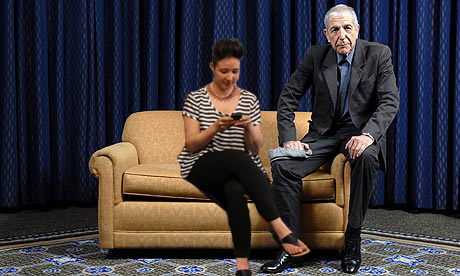
Matthew: I think that they are trying to show emerging performers what is possible. They succeeded in showing them a glimpse of that. Missie Peters organizes this festival and does a bang up job. There’s an honorary poet every year and it’s well put together. I am a big fan of this festival. http://victoriaspokenwordfestival.com/
Amy: Michael Enright, Rewind was amazing today: a young poet from a long time ago. Leonard Cohen! Look it up. Love him.
Matthew: Leonard who?
Amy: Hee hee. Profound stuff. And so young. I feel very frivolous now
Matthew: I was watching a video of him the other day He is translating French in this video while sitting on his balcony. Un Canadien Errant.
Amy: He is the definition of romantic.
Laakkuluk: I like to read his poetry at night and have profound and…erhm…fantastic dreams
Amy: You are a devil Laakkuluk. Sweet though!
Matthew: There you go, back in the creative space of your mind with Leonard Cohen
Amy: How profound…
Laakkuluk: Nurturing that space, respecting it…
Amy: So, we think the creative space is ultimately the mind. Cuz we can’t afford a physical space with lights and sound and stairs. So, as we say in Newfoundland we makes it up as we goes along.
Matthew: I see it more like even if you can afford the ideal space, the one you need to nurture is the mind
Laakkuluk: Yes – without an investment in the mind, the space is just a room
Matthew: Well, thanks again for a very soothing part of my week
Amy: Adieu
Matthew: Until then
Laakkuluk: Takuss!

